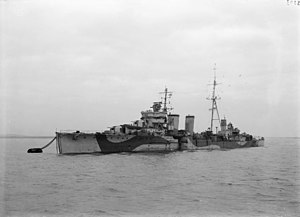
| |
| History | |
|---|---|
| Name | HMS Caledon |
| Builder | Cammell Laird |
| Laid down | 17 March 1916 |
| Launched | 25 November 1916 |
| Commissioned | 6 March 1917 |
| Decommissioned | April 1945 |
| Refit | Converted to anti-aircraft cruiser at Chatham Dockyard between 14 September 1942 and 7 December 1943 |
| Identification | Pennant number: 69 (Apr 17); 22 (Jan 18);[1] 65 (Apr 18); 53 (Nov 19); I53 (1936); D53(1940).[2] |
| Fate | Sold for scrap, 22 January 1948 |
| General characteristics (as built) | |
| Class and type | C-class light cruiser |
| Displacement | 4,238 long tons (4,306 t) normal; 4,911 long tons (4,990 t) full load |
| Length | |
| Beam | 42 ft 3 in (12.9 m) |
| Draught | 18 ft 9 in (5.72 m) (mean, deep load) |
| Installed power |
|
| Propulsion | 2 × shafts; 2 × geared steam turbines |
| Speed | 29 kn (54 km/h; 33 mph) |
| Complement | 438 |
| Armament |
|
| Armour |
|
| General characteristics (October 1944) | |
| Displacement | 5,240 long tons (5,320 t) full load |
| Armament |
|
HMS Caledon was a C-class light cruiser built for the Royal Navy during World War I. She was the name ship of the Caledon sub-class of the C class. She survived both world wars to be scrapped in 1948.
Cite error: There are <ref group=Note> tags on this page, but the references will not show without a {{reflist|group=Note}} template (see the help page).